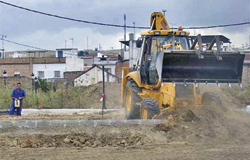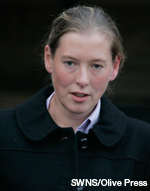To the passing coachloads, it is a non-descript patch of scrubland. But for local people, El Carrizal hides the horrors of the Civil War. MARK ROULSTON travels to Órgiva to hear the history of what could be Spain’s biggest mass grave
THE group meets inside the ayuntamiento in Órgiva. They are 500 and include Iván Ortiz Chanes, who is responsible for bringing everyone together, and local historian Juan Gonzalez Blasco.
It is a grey day, the second of the market town’s annual feria, but no-one is in any mood to party.
Most of the crowd is made up of the descendants of those murdered in cold blood during and after the civil war that tore Spain in two more than 70 years ago. And they are in the assembly room at the town hall to exchange information about the loved ones in, what is perhaps, the nation’s biggest mass grave.
The exact number of bodies that lie under the soils of the El Carrizal barranco (ravine) is unknown. Some say 2,500; others claim it is much higher, 4,000 plus. This is why we are here: it is the first step in discovering the truth, in unraveling the horrific past of that scrubland between Órgiva and Lanjaron in La Alpujarra.
“This meeting has been extremely useful in getting to know the surviving family members of the victims and in sharing information, knowledge and personal experiences about the mass grave at El Carrizal,” said Ortiz Chanes, who is from the Granada wing of the Association of the Recuperation of Historical Memory – a group that has been uncovering civil war mass graves around Spain for more than a decade.
It is a month after Supreme Court Judge Baltasar Garzon ordered a census of all those lying in communal graves (which include 40,000 plus in Andalucía alone). And the purpose of this meeting in Órgiva is to come up with as many names as possible of those buried under the ravine.
They are also here to discuss any future excavation of the site. Talk of any uncovering would have been kept to secret whispers until recently. But there is the now legislation that will support those who want to excavate the remains of loved ones who lie in mass graves.
In his book on the history of Órgiva, Hitos de su Historia, author Juan Gonzalez Blasco recounts the horrors of El Carrizal.
The road between Lanjaron and the town cuts this ravine in two. There is a make-shift cross on the upper part. Adorned with fake flowers, it bears the memorial: “In memory of Manuel LL and family on the 40th anniversary of their death.”
Under the soils here lie the remains of 149 people including the body of a mother of 11 children, who was shot by supporters of the military uprising along with her husband and eldest son.
The lower part of the barranco is an even bigger cemetery, although this is no consecrated land.
During research for the book Blasco spoke to a local pastor (shepherd) who, as a boy during the days and months after the Civil War, remembers truck after truck arriving at the barranco carrying prisoners from all over Granada and Málaga. The vehicles were unloaded and the captives executed.
The murderers, he relates, were 15 officers of the Guardia Civil – all from Murcia with “ugly moustaches and some with beards,” the pastor says. These enforcers of law and order were helped, in exhange for a bottle of anis, by La Escuadra Negra, the Black Squad, a gang made up of fascists from Órgiva and the nearby village of Las Barreras.
“The lorries would come every night. The prisoners were lined up and shot. We would hear gunshots all night long. Bang, bang, bang. Inmates from the jail at Órgiva would be marched out to bury the murdered, sometimes in mass graves containing 200 bodies.
“This went on for weeks and months. Sometimes there were as many as 80 people executed a night.”
As a boy, the shepherd remembers hearing the screams of the prisoners. “Sometimes I would hear ‘Murderers,’ ‘Criminals.’ But I also recall things like: ‘Don’t kill me. I have five children.’
“The dead are so many at Carrizal that there are tombs on top of tombs,” relates the shepherd, who wanted to remain anonymous in case of “reprisals.” That this was more than 60 years after the end of the conflict did not matter. The depth of feeling runs great with some, Blasco told me.
Indeed that is true. Recently, graffiti mocking the dead buried here was scrubbed off the plaque that marks this barranco as being very different from any other in Spain.
But did those who sprayed “Rojo Mierda” (Red Shit) really know what they were writing? Let’s hope it came from the hand of an ignorant teenager rather than that of someone whose ideology is more ingrained.
More atrocities
During the meeting in Órgiva, many personal histories of El Carrizal are told. We hear of armed fascists who, during the first days of the military uprising that led to civil war, came up to La Alpujarra from Motril.
The squadron scoured the village of Torzicon; going from house to house they rounded up 20 people – all of whom loyal to the Republic. These prisoners were marched to the barranco, shot and then covered with lime-rich soil.
But it is not only at El Carrizal are the horrors of the conflict known in La Alpujarra. Half of the 50 mass graves found in the province of Granada are in this mountainous region.
In the cemetery that towers over Órgiva, we hear there are at least 20 bodies dumped in a mass grave. And the accounts continue.
In August 1936, the staunchly-Repulican Torzicon was once again visited by supporters of the uprising. They took Manuel Rueda, his son and three other men, whose names are sadly unknown. They were taken to an area of scrubland outside the village of Alcazar in the Contraviesa mountains. They were asked to dig their own graves before they were murdered and buried together.
Days later, 25 more people were arrested in Torzicon. They were transported to the Lecrin Valley, shot and buried in a communal grave at Talará.
The most shocking story told that afternoon is saved until last. Elderly Pilar Góngora retells an experience lived by her mother, a goat herd. She was minding her flock at the Verdevique barranco in Cástaras when she saw a group of civil guards about to murder ten people, among them a 14-year-old boy.
But it was not what she saw that horrified my mother, it was what she heard, said Pilar: “Are you going to kill me even though I am your son?” said the boy.
There was a gunshot and the boy fell down dead. “Everyone knew the 14-year-old was the civil guard’s illegitimate son.”
‘Partial and debatable’
It is nine months since the Law of Historical Memory was passed. This legislation seeks to lift the veil of forgetfulness that descended upon Spain in the years and decades following the Civil War.
It is after more than 70 years that the conflict ended are people starting to talk about the crimes that were committed.
Neighbours who supported General Franco’s military uprising denounced neighbours who were supporters of the Republican government. And vice versa. There were kangaroo courts that resulted in death sentences handed out to thousands of innocent people. They were lined up, shot and dumped in mass graves.
These victims of murder eventually became nameless, their family members silenced. These crimes may have soon become forgotten were it not for this law.
But some have criticised this legislation. The Church and the right-wing political party, the Partido Popular, believe it unnecessarily reopens old wounds while sections of the Left believe it does not go far enough in declaring Franco’s 36-year-long dictatorship illegal.
There have also been calls to make someone accountable for all the atrocities committed in the years after the elected Republican government was replaced by the very bloody coup.
“For me, the Law of Historical Memory is partial and debatable. I think there is still a lot of deliberate obscurity in all of this. I would ask: ‘What was the name of the mayor of Orgiva who was shot in Granada along with his three brothers?’ Except for a few, nobody know. There is still no memory. It was López. Who knows López? Now they are forgotten.
“The Spanish have no interest in knowing our past, our history. And when we do have a little interest, we are unjustly attacked,” the historian said.
The immediate future of those who lie below El Carrizal is still unclear. But one day, there will be an uncovering of those mass graves. One day, the horrors of La Alpujarra will become known. The bones will be matched with names and decent burials given.



It’s so sad the way politics keep getting in the way with remembering these poor dead, people who were not to blame for any of what happened here. Oh, update on the San Rafael Cemetery in Malaga: the Junta stopped financing the excavation a couple of months ago, so it’s been stopped and it is not known if it will be finished before the Ayuntamiento start work on the Park.